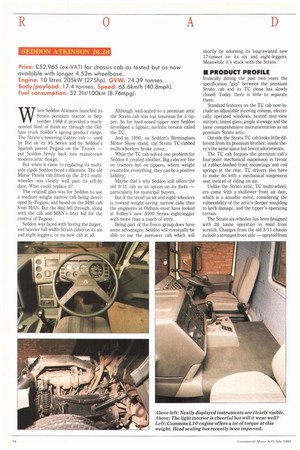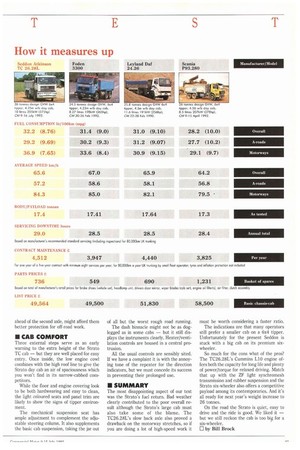W hen Seddon Atkinson launched its Strato premium tractor in September
Page 26

Page 28

Page 29

If you've noticed an error in this article please click here to report it so we can fix it.
1988 it provided a muchneeded blast of fresh air through the Oldham truck builder's ageing product range. The Strata's towering Cabtec cab — used by Daf on its 95 Series and by Seddon's Spanish parent Pegaso on the Ironer — put Seddon firmly back into mainstream modern artic design.
But when it came to replacing its multiaxle rigids Seddon faced a dilemma. The old Motor Panels cab fitted on the 3-11 multiwheeler was clearly well past its sell-by date. What could replace it?
The original plan was for Seddon to use a medium weight narrow cab being developed by Pegaso, and based on the M90 cab from MAN. But the deal fell through, along with the cab and MAN's later bid for the control of Pegaso.
Seddon was faced with having the larger, and heavier full-width Strato cabin on its six and eight-leggers, or no new cab at all. Although well-suited to a premium artic the Strato cab was too luxurious for a tipper. So for hard-nosed tipper men Seddon developed a lighter, no-frills version called the TC.
And in 1990, on Seddon's Birmingham Motor Show stand, the Strato TC-cabbed multi-wheelers broke cover.
While the TC cab solved one problem for Seddon it created another. Big cabs are fine on tractors but on tippers, where weight counts for everything, they can be a positive liability.
Maybe that's why Seddon still offers the old 3-11 cab as an option on its 6x4s — particularly for municipal buyers.
But if the trend on six and eight-wheelers is toward weight-saving narrow cabs then the engineers at Oldham must have looked at Foden's new 3000 Series eight-legger with more than a touch of envy.
Being part of the Iveco group does have some advantages. Seddon will eventually be able to use the narrower cab which will Ironically during the past two years the specification "gap" between the premium Strato cab and its TC clone has slowly closed. Today there is little to separate them.
Standard features on the TC cab now include an adjustable steering column, electrically operated windows, heated rear-view mirrors, tinted glass, ample stowage and the same comprehensive instrumentation as on premium Strato artic.
Outside the Strato TC cab looks little different from its premium brother; inside there's the same space but fewer adornments.
The TC cab forgoes the premium cab's four-point mechanical suspension in favour of rubber-bushed front mountings and coil springs at the rear. TC drivers also have to make do with a mechanical suspension seat instead of riding on air.
Unlike the Strata artic, TC multi-wheelers come with a shallower front air dam, which is a sensible move, considering the vulnerability of the artic's deeper moulding to kerb damage, and the tipper's operating terrain.
The Strata six-wheeler has been designed with 26 tonne operation in mind from scratch. Changes from the old 3-11 chassis include a stronger front axle — uprated from 6.5 tonnes to 7.1 tonnes. The 3-11's old RABA rear bogie has also gone in favour of single reduction Rockwell tandem axles with cross, as well as inter-axle differential locks.
The Rockwell bogie rides on the latest rubber springs from Hendrickson Norde. On the Strata tipper chassis there's an extra 76mm of clearance to allow for greater articulation. Wide 200mm linings provide the braking efficiency and an air dryer is fitted as standard.
There's a choice of either the lightweight charge-cooled 8.3-litre Cummins C Series rated at 198kW(265hp), or the larger capacity turbocharged 10-litre Cummins LbO pumping out 205kW(275hp). Peak torque for the two is 950Nm(7001bft) or 1,166Nm(8601bft) respectively — tippermen wanting more grunt will no doubt opt for the L10.
Cummins' 10-litre lump has benefited from a number of recent improvements. Engine noise has been cut by 1.5 decibels thanks to a stiffer gear case. Sump capacities have also gone up to 34 litres, so drain intervals can be as long as 32,000km.
A revised head gasket similar to that used on the B Series makes for improved sealing, while the mechanically actuated PT fuel system pump no longer needs to be adjusted in service.
A modified air/fuel control is said to make the engine more responsive and visible smoke has been reduced.
Standard gearbox is the alloy-cased ZF Ecomid nine-speed synchromesh — options are Eaton's 11609 nine-speed synchro or the popular 12-speed Twin Splitter.
Since our L10-powered Strato TC26.28L test truck was built the shortest unflitched 4,250mm wheelbase chassis has been superseded by a 4,520mm model, rear axle capacities have also gone up from 9,400kg to 9,660kg. Unladen weights have also risen from 6,983kg to 7,003kg.
Seddon's truck badging is straightforward: the first two figures refer to gross weight; the second set to nominal horsepower.
• PRODUCTIVITY
Two days of torrential rain did nothing for our TC26.28L's chances of returning a competitive fuel consumption. And this was made worse by the comparatively poor aerodynamics of the six-legger's tall Strato cab, which is at least 320mm higher than its nearest rival.
The combined effect showed up most clearly over the motorway section where the Strato's 36.91it/100km(7.65mpg) was well-behind narrow-cabbed competition such as Leyland Daf Constructor 24.26, ERF ES8 and Foden 3300.
On the motorway the Strata's slow 5.57:1 back axle also didn't help. Being geared for a top speed of only 101km/h mum torque. At these speeds the big cab had less influence on fuel consumption.
The TC26.28L's fuel returns over this section support this — its 29.21it/100km(9.69mpg) on A-roads is impressively frugal as our comparison charts show.
The TC26.28L's big cab might catch the wind on the motorway but Seddon has done a good job on keeping its overall weight down. Even with the 10-litre engine the Strata 6x4, with standard rubber suspension, has a body/payload allowance of 17.4 tonnes which it is certainly on a par with both the Fader) 3300, also running on rubber, and the Scania P93-280.
• ON THE ROAD
The L10 engine, with its 205kW rating, is relatively lightly stressed, which should mean a long trouble-free life. There's not much more power than some of the smaller capacity engines in its competitors but there is a lot more torque so even with a ninespeed box it minimizes gear changing.
On the road the TC 26.28L is quite a lazy vehicle to drive which could partly account for the average journey times. If the engine is kept revving the TC26.28L would undoubtedly respond with faster average speeds, although accelerating up to 80km/h from rest it is well up with the pack.
The ZF synchromesh box and Cablecraft linkage provide surprisingly fast gear changes. The Econnid's one failing becomes apparent on hill climbs when the lever has to pass through the central detent activating the rangechange. This inevitably leads to a slower change than usual, often at what is the most critical point of the climb. To change down early or take two steps down the box are the only options if reasonable momentum is to be maintained.
The good articulation on the Strato's rubber suspension helps to keep the drive wheels in contact with the ground over the roughest terrain and the cross-axle and inter-axle differential locks add to traction capability. The overall ride is good and steering and braking what we expect from a Seddon six-wheeler.
Higher mounting of the brake actuators, ahead of the second axle, might afford them better protection for off-road work,
• CAB COMFORT
Three external steps serve as an early warning to the extra height of the Strato TC cab but they are well placed for easy entry. Once inside, the low engine cowl combines with the high roof line to give the Strato day cab an air of spaciousness which you won't find in its narrow-cabbed competitors.
While the floor and engine covering look to be both hardwearing and easy to clean, the light coloured seats and panel trim are likely to show the signs of tipper environment.
The mechanical suspension seat has ample adjustment to complement the adjustable steering column. It also supplements the basic cab suspension, taking the jar out of all but the worst rough road running.
The dash binnacle might not be as doglegged as in some cabs but it still displays the instruments clearly. Heater/ventilation controls are housed in a central protrusion.
All the usual controls are sensibly sited. If we have a complaint it is with the annoying tone of the repeater for the direction indicators, but we must concede its success in preventing their prolonged use.
• SUMMARY
The most disappointing aspect of our test was the Strato's fuel return, Bad weather clearly contributed to the poor overall result although the Strato's large cab must also take some of the blame. The TC26.28L's slow back axle also proved a drawback on the motorway stretches, so if you are doing a lot of high-speed work it must be worth considering a faster ratio.
The indications are that many operators still prefer a smaller cab on a 6x4 tipper. Unfortunately for the present Seddon is stuck with a big cab on its premium sixwheeler.
So much for the cons what of the pros? The TC26.28L's Cummins L10 engine offers both the capacity for long life and plenty of power/torque for relaxed driving. Match that up with the 2F light synchromesh transmission and rubber suspension and the Strato six-wheeler also offers a competitive payload among its contemporaries. And it's all ready for next year's weight increase to 26 tonnes, On the road the Strato is quiet, easy to drive and the ride is good. We liked it but we still reckon the cab is too big for a six-wheeler.
0 by Bill Brock












































































